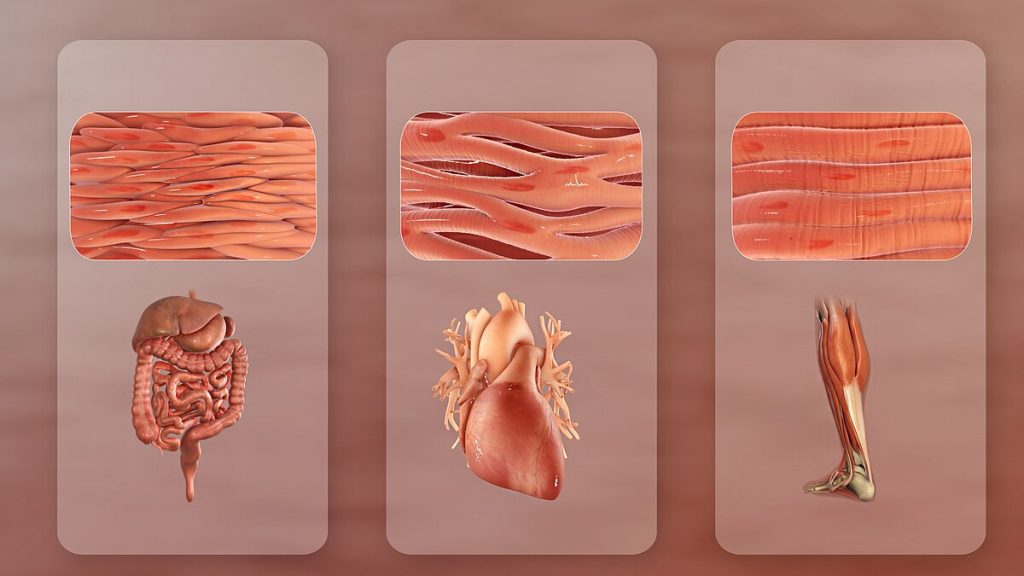7.2 Muscle Tissue
Muscle Tissue[1]
Types of Muscle Tissue
Muscle tissue is classified into three types according to its structure and function: skeletal, cardiac, and smooth. See Table 7.2 for a brief description of the three types of muscle tissue.
Table 7.2. Comparison of Structure and Properties of Types of Muscle[2]
Tissue |
Structure |
Function |
Location |
|---|---|---|---|
| Skeletal | Long cylindrical fibers, striated, many peripherally located nuclei | Under voluntary control and produces heat and protects organs | Attached to bones and around entrance points to body (e.g., mouth, anus) |
| Cardiac | Short, branched fibers, striated, single central nucleus, has intercalated discs | Under involuntary control and contracts to pump blood | Heart |
| Smooth | Short, spindle-shaped, no striations, single nucleus in each cell | Under involuntary control and moves substances, such as food, air, blood, and urine, through hollow organs and tubes | Walls of major organs and passageways |
Functions of Muscle Tissue
The primary function of muscle tissue is to contract and produce movement of the body. Some muscle movement is voluntary, which means it is under conscious control. For example, when you want to move your arm or any other part of the body, you can choose to do so. Other movements are involuntary, meaning they are not under conscious control, such as the contraction of your pupil in bright light.
Skeletal muscles act not only to produce voluntary movement of the body but also to stop movement, such as resisting gravity to maintain posture. It is a complex job to balance the body on two feet and walk upright. The muscles of the vertebral column, thorax, and abdominal wall extend, flex, and stabilize different parts of the body’s trunk. The deep muscles in the core of the body help maintain posture. Muscles also prevent excess movement of the bones and joints, maintaining skeletal stability and preventing skeletal structure damage or deformation.
Additionally, skeletal muscles contribute to the maintenance of homeostasis in the body by generating heat. Muscle contraction requires energy, and when ATP is broken down, heat is produced. This heat is very noticeable during exercise, when sustained muscle movement causes body temperature to rise, and in cases of extreme cold, when shivering produces random skeletal muscle contractions to generate heat. Shivering is an involuntary contraction of skeletal muscles in response to a lower-than-normal body temperature.
Muscles are also responsible for the transport and storage of substances. While most skeletal muscles are attached to bones, some skeletal muscles are also located throughout the body at the openings of internal tracts to control the movement of various substances. These muscles allow functions, such as swallowing, urination, and defecation, to be under voluntary control. Smooth muscle allows the movement of substances through passageways such as the blood vessels and intestines. Cardiac muscle pumps blood throughout the body.
Properties of Muscle Tissue
All types of muscle tissue have four unique properties that include electrical excitability, contractility, extensibility, and elasticity.
Muscle cells are excitable in response to nervous system stimulation. While the nervous system can influence the excitability of cardiac and smooth muscle to some degree, skeletal muscle completely depends on signaling from the nervous system to work properly. On the other hand, both cardiac muscle and smooth muscle can respond to other stimuli, such as hormones and local stimuli. A muscle can return to its original length when relaxed due to a quality of muscle tissue called elasticity. It can recoil back to its original length due to elastic fibers. Contractility allows muscle tissue to pull on its attachment points and shorten with force. Muscle tissue also has extensibility, meaning it can stretch or extend and still contract.
Differences among the three muscle types include the microscopic organization of their contractile proteins—actin and myosin. The actin and myosin proteins are arranged in an alternating pattern in the cytoplasm of individual muscle fibers (cells are referred to as fibers in muscle) in both skeletal muscle and cardiac muscle. This pattern creates stripes called striations. The striations are visible with a light microscope under high magnification. Skeletal muscle fibers are multinucleated (containing up to 100 or more nuclei). Cardiac muscle fibers each have one to two nuclei and are physically and electrically connected to each other by special structures called intercalated discs so that the entire heart contracts as one unit (called a syncytium).
Because the actin and myosin are not arranged in such regular fashion in smooth muscle, the cytoplasm of a smooth muscle fiber (which has only a single nucleus) has a uniform, non-striated appearance (resulting in the name smooth muscle). However, the less organized appearance of smooth muscle should not be interpreted as less efficient. Smooth muscle in the walls of arteries is a critical component that regulates blood pressure necessary to push blood through the circulatory system. Smooth muscle in the skin, visceral organs, and internal passageways is essential for moving all materials through the body.
See Figure 7.1[3] for microscopic images of the three types of muscle tissue.

The remaining sections of this chapter will further describe each type of muscle tissue.
- Betts, J. G., Young, K. A., Wise, J. A., Johnson, E., Poe, B., Kruse, D. H., Korol, O., Johnson, J. E., Womble, M., & DeSaix, P. (2022). Anatomy and physiology 2e. OpenStax. https://openstax.org/books/anatomy-and-physiology-2e/pages/1-introduction ↵
- Betts, J. G., Young, K. A., Wise, J. A., Johnson, E., Poe, B., Kruse, D. H., Korol, O., Johnson, J. E., Womble, M., & DeSaix, P. (2022). Anatomy and physiology 2e. OpenStax. https://openstax.org/books/anatomy-and-physiology-2e/pages/1-introduction ↵
- “Types_Of_Muscle.jpg” by www.scientificanimations.com is licensed under CC BY-SA 4.0 ↵
Muscle movement that is under conscious control.
Describes muscle movement that occurs without conscious control.
Able to respond to stimulation from the nervous system by generating an electrical signal.
The ability of muscle tissue to return to its original length after being stretched, due to the presence of elastic fibers.
The ability of muscle tissue to shorten with force and pull on its attachment points.
The ability of muscle tissue to stretch or extend without being damaged and still contract.
Stripes in muscle tissue created by the regular arrangement of proteins within the cells.
Striated muscle tissue attached to bones that enables movement, facial expressions, posture, and other voluntary actions.
Involuntary, striated muscle tissue found only in the heart.
Involuntary, non-striated muscle tissue found in the walls of organs.

